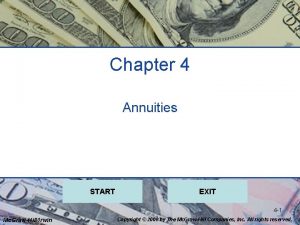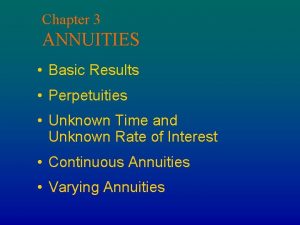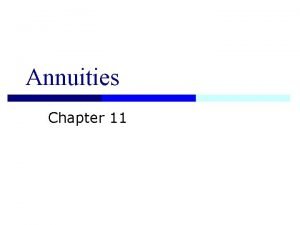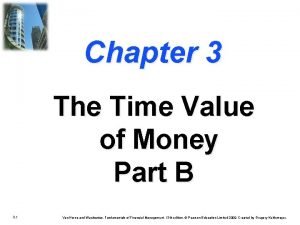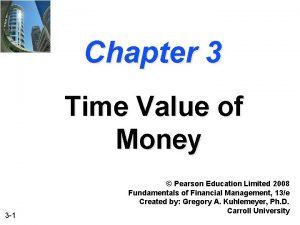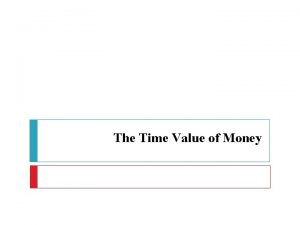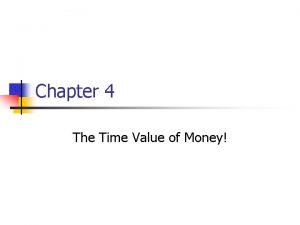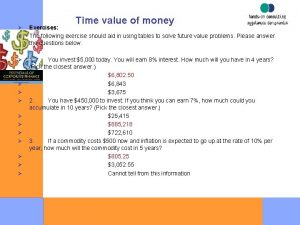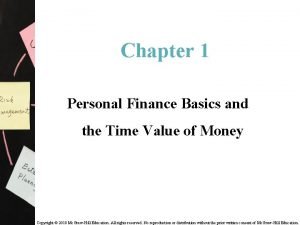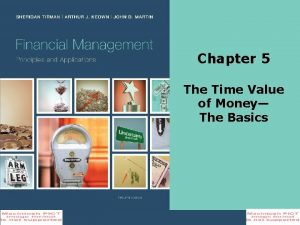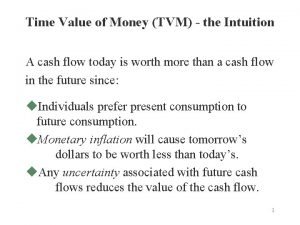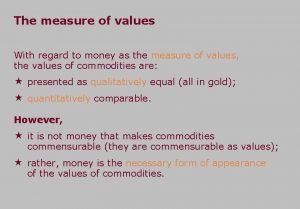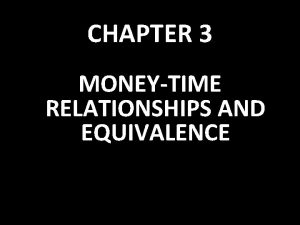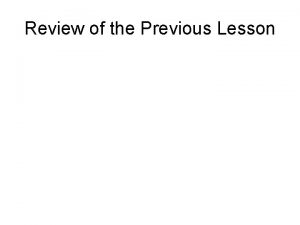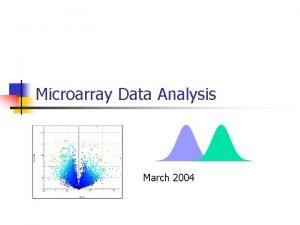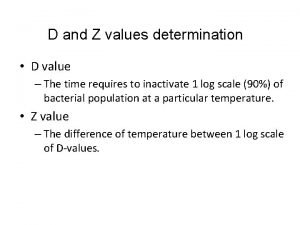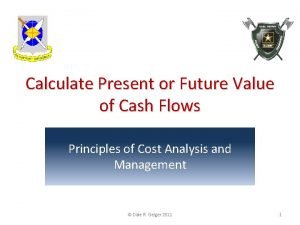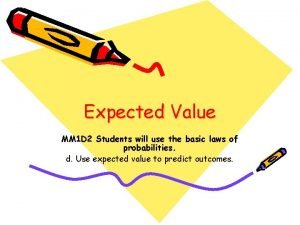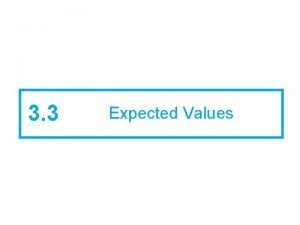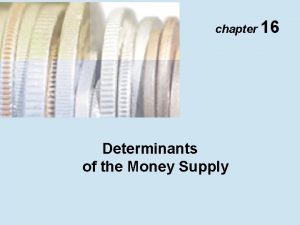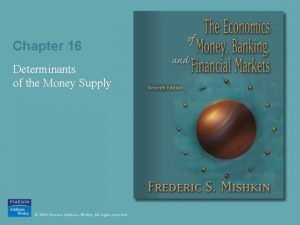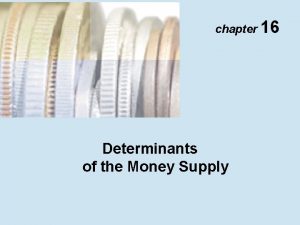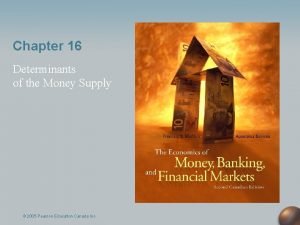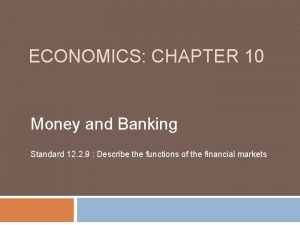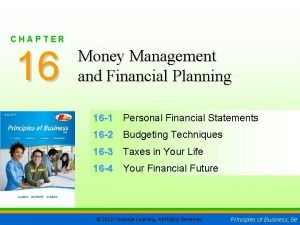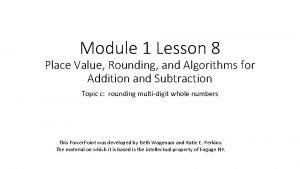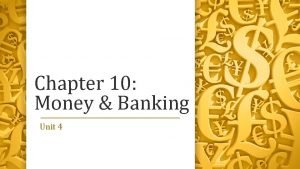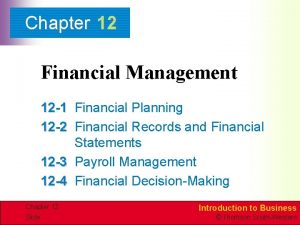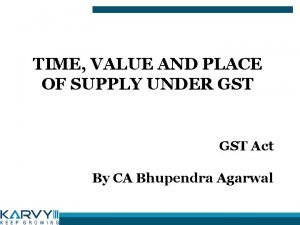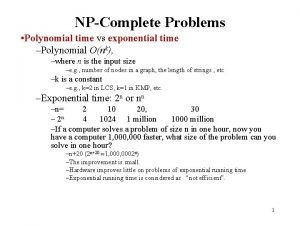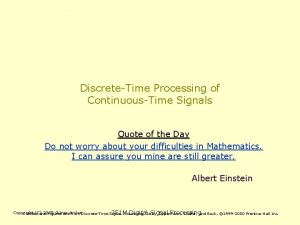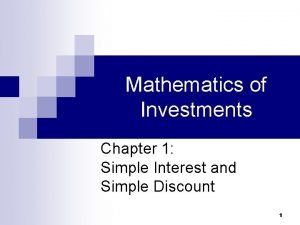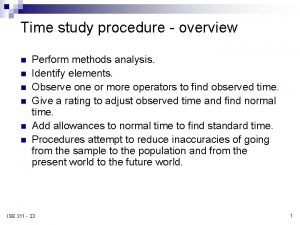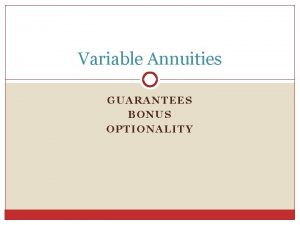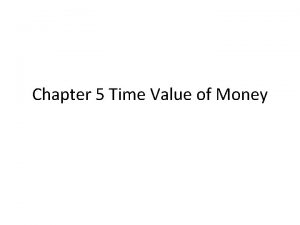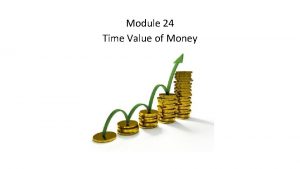Chapter 6 The Time Value of Money Annuities





























































































































![Step 3: Solve (cont. ) [ • PV = $300 { 1 -(1/(1. 10)5] Step 3: Solve (cont. ) [ • PV = $300 { 1 -(1/(1. 10)5]](https://slidetodoc.com/presentation_image_h2/8c55aefeb6f7c8ad29eaedcbaec733a6/image-126.jpg)









- Slides: 135

• Chapter 6 The Time Value of Money: Annuities and Other Topics Copyright © 2011 Pearson Prentice Hall. All rights reserved.

Slide Contents • Learning Objectives • Principles Used in This Chapter 1. Annuities 2. Perpetuities 3. Complex Cash Flow Streams Copyright © 2011 Pearson Prentice Hall. All rights reserved. 6 -2

Learning Objectives 1. Distinguish between an ordinary annuity and an annuity due, and calculate present and future values of each. 2. Calculate the present value of a level perpetuity and a growing perpetuity. 3. Calculate the present and future value of complex cash flow streams. Copyright © 2011 Pearson Prentice Hall. All rights reserved. 6 -3

Principles Used in This Chapter • Principle 1: Money Has a Time Value. – This chapter applies the time value of money concepts to annuities, perpetuities and complex cash flows. • Principle 3: Cash Flows Are the Source of Value. – This chapter introduces the idea that principle 1 and principle 3 will be combined to value stocks, bonds, and investment proposals. Copyright © 2011 Pearson Prentice Hall. All rights reserved. 6 -4

6. 1 Annuities Copyright © 2011 Pearson Prentice Hall. All rights reserved.

Ordinary Annuities • An annuity is a series of equal dollar payments that are made at the end of equidistant points in time such as monthly, quarterly, or annually over a finite period of time. • If payments are made at the end of each period, the annuity is referred to as ordinary annuity. Copyright © 2011 Pearson Prentice Hall. All rights reserved. 6 -6

Ordinary Annuities (cont. ) • Example 6. 1 How much money will you accumulate by the end of year 10 if you deposit $3, 000 each for the next ten years in a savings account that earns 5% per year? • We can determine the answer by using the equation for computing the future value of an ordinary annuity. Copyright © 2011 Pearson Prentice Hall. All rights reserved. 6 -7

The Future Value of an Ordinary Annuity • FVn = FV of annuity at the end of nth period. • PMT = annuity payment deposited or received at the end of each period • i = interest rate period • n = number of periods for which annuity will last Copyright © 2011 Pearson Prentice Hall. All rights reserved. 6 -8

The Future Value of an Ordinary Annuity (cont. ) • FV = $3000 {[ (1+. 05)10 - 1] ÷ (. 05)} = $3, 000 { [0. 63] ÷ (. 05) } = $3, 000 {12. 58} = $37, 740 Copyright © 2011 Pearson Prentice Hall. All rights reserved. 6 -9

The Future Value of an Ordinary Annuity (cont. ) • Using a Financial Calculator • Enter – N=10 – 1/y = 5. 0 – PV = 0 – PMT = -3000 – FV = $37, 733. 67 Copyright © 2011 Pearson Prentice Hall. All rights reserved. 6 -10

The Future Value of an Ordinary Annuity (cont. ) • Using an Excel Spreadsheet • FV of Annuity – = FV(rate, nper, pmt, pv) – =FV(. 05, 10, -3000, 0) – = $37, 733. 68 Copyright © 2011 Pearson Prentice Hall. All rights reserved. 6 -11

Solving for PMT in an Ordinary Annuity • Instead of figuring out how much money you will accumulate (i. e. FV), you may like to know how much you need to save each period (i. e. PMT) in order to accumulate a certain amount at the end of n years. • In this case, we know the values of n, i, and FVn in equation 6 -1 c and we need to determine the value of PMT. Copyright © 2011 Pearson Prentice Hall. All rights reserved. 6 -12

Solving for PMT in an Ordinary Annuity (cont. ) • Example 6. 2: Suppose you would like to have $25, 000 saved 6 years from now to pay towards your down payment on a new house. If you are going to make equal annual end-of-year payments to an investment account that pays 7 per cent, how big do these annual payments need to be? Copyright © 2011 Pearson Prentice Hall. All rights reserved. 6 -13

Solving for PMT in an Ordinary Annuity (cont. ) • Here we know, FVn = $25, 000; n = 6; and i=7% and we need to determine PMT. Copyright © 2011 Pearson Prentice Hall. All rights reserved. 6 -14

Solving for PMT in an Ordinary Annuity (cont. ) • $25, 000 = PMT {[ (1+. 07)6 - 1] ÷ (. 07)} = PMT{ [. 50] ÷ (. 07) } = PMT {7. 153} $25, 000 ÷ 7. 153 = PMT = $3, 495. 03 Copyright © 2011 Pearson Prentice Hall. All rights reserved. 6 -15

Solving for PMT in an Ordinary Annuity (cont. ) • Using a Financial Calculator. • Enter – N=6 – 1/y = 7 – PV = 0 – FV = 25000 – PMT = -3, 494. 89 Copyright © 2011 Pearson Prentice Hall. All rights reserved. 6 -16

Checkpoint 6. 1 Solving for an Ordinary Annuity Payment How much must you deposit in a savings account earning 8% annual interest in order to accumulate $5, 000 at the end of 10 years? Let’s solve this problem using the mathematical formulas, a financial calculator, and an Excel spreadsheet. Copyright © 2011 Pearson Prentice Hall. All rights reserved. 6 -17

Checkpoint 6. 1 Copyright © 2011 Pearson Prentice Hall. All rights reserved. 6 -18

Checkpoint 6. 1 Copyright © 2011 Pearson Prentice Hall. All rights reserved. 6 -19

Checkpoint 6. 1 Copyright © 2011 Pearson Prentice Hall. All rights reserved. 6 -20

Checkpoint 6. 1: Check Yourself If you can earn 12 percent on your investments, and you would like to accumulate $100, 000 for your child’s education at the end of 18 years, how much must you invest annually to reach your goal? Copyright © 2011 Pearson Prentice Hall. All rights reserved. 6 -21

Step 1: Picture the Problem i=12% 0 1 2… PMT 18 Years Cash flow PMT The FV of annuity for 18 years At 12% = $100, 000 We are solving for PMT Copyright © 2011 Pearson Prentice Hall. All rights reserved. 6 -22

Step 2: Decide on a Solution Strategy • This is a future value of an annuity problem where we know the n, i, FV and we are solving for PMT. • We will use equation 6 -1 c to solve the problem. Copyright © 2011 Pearson Prentice Hall. All rights reserved. 6 -23

Step 3: Solution • Using the Mathematical Formula • $100, 000 = PMT {[ (1+. 12)18 - 1] ÷ (. 12)} = PMT{ [6. 69] ÷ (. 12) } = PMT {55. 75} $100, 000 ÷ 55. 75 = PMT = $1, 793. 73 Copyright © 2011 Pearson Prentice Hall. All rights reserved. 6 -24

Step 3: Solution (cont. ) • Using a Financial Calculator. • Enter – N=18 – 1/y = 12. 0 – PV = 0 – FV = 100000 – PMT = -1, 793. 73 Copyright © 2011 Pearson Prentice Hall. All rights reserved. 6 -25

Step 3: Solution (cont. ) • Using an Excel Spreadsheet • PMT = PMT (rate, nper, pv, fv) = PMT(. 12, 18, 0, 100000) = $1, 793. 73 at the end of each year Copyright © 2011 Pearson Prentice Hall. All rights reserved. 6 -26

Step 4: Analyze • If we contribute $1, 793. 73 every year for 18 years, we should be able to reach our goal of accumulating $100, 000 if we earn a 12% return on our investments. • Note the last payment of $1, 793. 73 occurs at the end of year 18. In effect, the final payment does not have a chance to earn any interest. Copyright © 2011 Pearson Prentice Hall. All rights reserved. 6 -27

Solving for Interest Rate in an Ordinary Annuity • You can also solve for “interest rate” you must earn on your investment that will allow your savings to grow to a certain amount of money by a future date. • In this case, we know the values of n, PMT, and FVn in equation 6 -1 c and we need to determine the value of i. Copyright © 2011 Pearson Prentice Hall. All rights reserved. 6 -28

Solving for Interest Rate in an Ordinary Annuity • Example 6. 3: In 20 years, you are hoping to have saved $100, 000 towards your child’s college education. If you are able to save $2, 500 at the end of each year for the next 20 years, what rate of return must you earn on your investments in order to achieve your goal? Copyright © 2011 Pearson Prentice Hall. All rights reserved. 6 -29

Solving for Interest Rate in an Ordinary Annuity (cont. ) • Using the Mathematical Formula • $100, 000 = $2, 500 • 40 = {[ {[ (1+i)20 - 1] ÷ ÷ (i)}] (i)} • The only way to solve for “i” mathematically is by trial and error. Copyright © 2011 Pearson Prentice Hall. All rights reserved. 6 -30

Solving for Interest Rate in an Ordinary Annuity (cont. ) • We will have to substitute different numbers for i until we find the value of i that makes the right hand side of the expression equal to 40. Copyright © 2011 Pearson Prentice Hall. All rights reserved. 6 -31

Solving for Interest Rate in an Ordinary Annuity (cont. ) • Using a Financial Calculator • Enter – N = 20 – PMT = -$2, 500 – FV = $100, 000 – PV = $0 – i = 6. 77 Copyright © 2011 Pearson Prentice Hall. All rights reserved. 6 -32

Solving for Interest Rate in an Ordinary Annuity (cont. ) • Using an Excel Spreadsheet • i = Rate (nper, PMT, pv, fv) • = Rate (20, 2500, 0, 100000) • = 6. 77% Copyright © 2011 Pearson Prentice Hall. All rights reserved. 6 -33

Solving for the Number of Periods in an Ordinary Annuity • You may want to calculate the number of periods it will take for an annuity to reach a certain future value, given interest rate. • It is easier to solve for number of periods using financial calculator or excel, rather than mathematical formula. Copyright © 2011 Pearson Prentice Hall. All rights reserved. 6 -34

Solving for the Number of Periods in an Ordinary Annuity (cont. ) • Example 6. 4: Suppose you are investing $6, 000 at the end of each year in an account that pays 5%. How long will it take before the account is worth $50, 000? Copyright © 2011 Pearson Prentice Hall. All rights reserved. 6 -35

Solving for the Number of Periods in an Ordinary Annuity (cont. ) • Using a Financial Calculator • Enter – 1/y = 5. 0 – PV = 0 – PMT = -6, 000 – FV = 50, 000 – N = 7. 14 Copyright © 2011 Pearson Prentice Hall. All rights reserved. 6 -36

Solving for the Number of Periods in an Ordinary Annuity (cont. ) • Using an Excel Spreadsheet • n = NPER(rate, pmt, pv, fv) • n = NPER(5%, -6000, 0, 50000) • n = 7. 14 years • Thus it will take 7. 13 years for annual deposits of $6, 000 to grow to $50, 000 at an interest rate of 5% Copyright © 2011 Pearson Prentice Hall. All rights reserved. 6 -37

The Present Value of an Ordinary Annuity • The present value of an ordinary annuity measures the value today of a stream of cash flows occurring in the future. Copyright © 2011 Pearson Prentice Hall. All rights reserved. 6 -38

The Present Value of an Ordinary Annuity (cont. ) • For example, we will compute the PV of ordinary annuity if we wish to answer the question: what is the value today or lump sum equivalent of receiving $3, 000 every year for the next 30 years if the interest rate is 5%? Copyright © 2011 Pearson Prentice Hall. All rights reserved. 6 -39

The Present Value of an Ordinary Annuity (cont. ) • Figure 6 -2 shows the lump sum equivalent ($2, 106. 18) of receiving $500 per year for the next five years at an interest rate of 6%. Copyright © 2011 Pearson Prentice Hall. All rights reserved. 6 -40

Copyright © 2011 Pearson Prentice Hall. All rights reserved. 6 -41

The Present Value of an Ordinary Annuity (cont. ) • PMT = annuity payment deposited or received at the end of each period. • i = discount rate (or interest rate) on a period basis. • n = number of periods for which the annuity will last. Copyright © 2011 Pearson Prentice Hall. All rights reserved. 6 -42

The Present Value of an Ordinary Annuity (cont. ) • Note , it is important that “n” and “i” match. If periods are expressed in terms of number of monthly payments, the interest rate must be expressed in terms of the interest rate per month. Copyright © 2011 Pearson Prentice Hall. All rights reserved. 6 -43

Checkpoint 6. 2 The Present Value of an Ordinary Annuity Your grandmother has offered to give you $1, 000 per year for the next 10 years. What is the present value of this 10 -year, $1, 000 annuity discounted back to the present at 5 percent? Let’s solve this using the mathematical formula, a financial calculator, and an Excel spreadsheet. Copyright © 2011 Pearson Prentice Hall. All rights reserved. 6 -44

Checkpoint 6. 2 Copyright © 2011 Pearson Prentice Hall. All rights reserved. 6 -45

Checkpoint 6. 2 Copyright © 2011 Pearson Prentice Hall. All rights reserved. 6 -46

Checkpoint 6. 2: Check Yourself What is the present value of an annuity of $10, 000 to be received at the end of each year for 10 years given a 10 percent discount rate? Copyright © 2011 Pearson Prentice Hall. All rights reserved. 6 -47

Step 1: Picture the Problem i=10% 0 1 2… 10 Years Cash flow $10, 000 Sum up the present Value of all the cash flows to find the PV of the annuity Copyright © 2011 Pearson Prentice Hall. All rights reserved. 6 -48

Step 2: Decide on a Solution Strategy • In this case we are trying to determine the present value of an annuity. We know the number of years (n), discount rate (i), dollar value received at the end of each year (PMT). • We can use equation 6 -2 b to solve this problem. Copyright © 2011 Pearson Prentice Hall. All rights reserved. 6 -49

Step 3: Solution • Using the Mathematical Formula [ • PV = $10, 000 { 1 -(1/(1. 10)10] ÷ (. 10)} = $10, 000 {[ 0. 6145] ÷ (. 10)} = $10, 000 {6. 145) = $ 61, 445 Copyright © 2011 Pearson Prentice Hall. All rights reserved. 6 -50

Step 3: Solution (cont. ) • Using a Financial Calculator • Enter – N = 10 – 1/y = 10. 0 – PMT = -10, 000 – FV = 0 – PV = 61, 445. 67 Copyright © 2011 Pearson Prentice Hall. All rights reserved. 6 -51

Step 3: Solution (cont. ) • Using an Excel Spreadsheet • PV = PV (rate, nper, pmt, fv) • PV = PV (0. 10, 10000, 0) • PV = $61, 445. 67 Copyright © 2011 Pearson Prentice Hall. All rights reserved. 6 -52

Step 4: Analyze • A lump sum or one time payment today of $61, 446 is equivalent to receiving $10, 000 every year for 10 years given a 10 percent discount rate. Copyright © 2011 Pearson Prentice Hall. All rights reserved. 6 -53

Amortized Loans • An amortized loan is a loan paid off in equal payments – consequently, the loan payments are an annuity. • Examples: Home mortgage loans, Auto loans Copyright © 2011 Pearson Prentice Hall. All rights reserved. 6 -54

Amortized Loans (cont. ) • In an amortized loan, the present value can be thought of as the amount borrowed, n is the number of periods the loan lasts for, i is the interest rate period, future value takes on zero because the loan will be paid of after n periods, and payment is the loan payment that is made. Copyright © 2011 Pearson Prentice Hall. All rights reserved. 6 -55

Amortized Loans (cont. ) • Example 6. 5 Suppose you plan to get a $9, 000 loan from a furniture dealer at 18% annual interest with annual payments that you will pay off in over five years. What will your annual payments be on this loan? Copyright © 2011 Pearson Prentice Hall. All rights reserved. 6 -56

Amortized Loans (cont. ) • Using a Financial Calculator • Enter –N=5 – i/y = 18. 0 – PV = 9000 – FV = 0 – PMT = -$2, 878. 00 Copyright © 2011 Pearson Prentice Hall. All rights reserved. 6 -57

The Loan Amortization Schedule Year Amount Owed Annuity on Principal at Payment the Beginning (2) of the Year (1) Interest Portion of the Annuity (3) = (1) × 18% Repaymen t of the Principal Portion of the Annuity (4) = (2) –(3) Outstanding Loan Balance at Year end, After the Annuity Payment (5) =(1) – (4) 1 $9, 000 $2, 878 $1, 620. 00 $1, 258. 00 $7, 742. 00 2 $7, 742 $2, 878 $1, 393. 56 $1, 484. 44 $6, 257. 56 3 $6257. 56 $2, 878 $1, 126. 36 $1, 751. 64 $4, 505. 92 $2, 878 $811. 07 $2, 066. 93 $2, 438. 98 5 $2, 438. 98 $2, 878 $439. 02 $2, 438. 98 $0. 00 Copyright © 2011 Pearson Prentice Hall. All rights reserved. 6 -58

The Loan Amortization Schedule (cont. ) • We can observe the following from the table: – Size of each payment remains the same. – However, Interest payment declines each year as the amount owed declines and more of the principal is repaid. Copyright © 2011 Pearson Prentice Hall. All rights reserved. 6 -59

Amortized Loans with Monthly Payments • Many loans such as auto and home loans require monthly payments. This requires converting n to number of months and computing the monthly interest rate. Copyright © 2011 Pearson Prentice Hall. All rights reserved. 6 -60

Amortized Loans with Monthly Payments (cont. ) • Example 6. 6 You have just found the perfect home. However, in order to buy it, you will need to take out a $300, 000, 30 year mortgage at an annual rate of 6 percent. What will your monthly mortgage payments be? Copyright © 2011 Pearson Prentice Hall. All rights reserved. 6 -61

Amortized Loans with Monthly Payments (cont. ) • Mathematical Formula • Here annual interest rate =. 06, number of years = 30, m=12, PV = $300, 000 Copyright © 2011 Pearson Prentice Hall. All rights reserved. 6 -62

Amortized Loans with Monthly Payments (cont. ) – $300, 000= PMT 1 - 1/(1+. 06/12)360. 06/12 $300, 000 = PMT [166. 79] $300, 000 ÷ 166. 79 = $1798. 67 Copyright © 2011 Pearson Prentice Hall. All rights reserved. 6 -63

Amortized Loans with Monthly Payments (cont. ) • Using a Financial Calculator • Enter – N=360 – 1/y =. 5 – PV = 300000 – FV = 0 – PMT = -1798. 65 Copyright © 2011 Pearson Prentice Hall. All rights reserved. 6 -64

Amortized Loans with Monthly Payments (cont. ) • Using an Excel Spreadsheet • PMT = PMT (rate, nper, pv, fv) • PMT = PMT (. 005, 360, 300000, 0) • PMT = -$1, 798. 65 Copyright © 2011 Pearson Prentice Hall. All rights reserved. 6 -65

Checkpoint 6. 3 Determining the Outstanding Balance of a Loan Let’s say that exactly ten years ago you took out a $200, 000, 30 -year mortgage with an annual interest rate of 9 percent and monthly payments of $1, 609. 25. But since you took out that loan, interest rates have dropped. You now have the opportunity to refinance your loan at an annual rate of 7 percent over 20 years. You need to know what the outstanding balance on your current loan is so you can take out a lowerinterest-rate loan and pay it off. If you just made the 120 th payment and have 240 payments remaining, what’s your current loan balance? Copyright © 2011 Pearson Prentice Hall. All rights reserved. 6 -66

Checkpoint 6. 3 Copyright © 2011 Pearson Prentice Hall. All rights reserved. 6 -67

Checkpoint 6. 3 Copyright © 2011 Pearson Prentice Hall. All rights reserved. 6 -68

Checkpoint 6. 3 Copyright © 2011 Pearson Prentice Hall. All rights reserved. 6 -69

Checkpoint 6. 3: Check Yourself Let’s assume you took out a $300, 000, 30 -year mortgage with an annual interest rate of 8%, and monthly payment of $2, 201. 29. Since you have made 15 years worth of payments, there are 180 monthly payments left before your mortgage will be totally paid off. How much do you still owe on your mortgage? Copyright © 2011 Pearson Prentice Hall. All rights reserved. 6 -70

Step 1: Picture the Problem i=(. 08/12)% Years Cash flow 0 PV 1 $2, 201. 29 2… $2, 201. 29 180 $2, 201. 29 We are solving for PV of 180 payments of $2, 201. 29 Using a discount rate of 8%/12 Copyright © 2011 Pearson Prentice Hall. All rights reserved. 6 -71

Step 2: Decide on a Solution Strategy • You took out a 30 -year mortgage of $300, 000 with an interest rate of 8% and monthly payment of $2, 201. 29. Since you have made payments for 15 -years (or 180 months), there are 180 payments left before the mortgage will be fully paid off. Copyright © 2011 Pearson Prentice Hall. All rights reserved. 6 -72

Step 2: Decide on a Solution Strategy (cont. ) • The outstanding balance on the loan at anytime is equal to the present value of all the future monthly payments. • Here we will use equation 6 -2 c to determine the present value of future payments for the remaining 15 -years or 180 months. Copyright © 2011 Pearson Prentice Hall. All rights reserved. 6 -73

Step 3: Solve • Using Mathematical Formula • Here annual interest rate =. 09; number of years =15, m = 12, PMT = $2, 201. 29 Copyright © 2011 Pearson Prentice Hall. All rights reserved. 6 -74

Solve (cont. ) – PV = $2, 201. 29 1 - 1/(1+. 08/12)180. 08/12 = $2, 201. 29 [104. 64] = $230, 344. 95 Copyright © 2011 Pearson Prentice Hall. All rights reserved. 6 -75

Solve (cont. ) • Using a Financial Calculator • Enter – N = 180 – 1/y =8/12 – PMT = -2201. 29 – FV = 0 – PV = $230, 344. 29 Copyright © 2011 Pearson Prentice Hall. All rights reserved. 6 -76

Solve (cont. ) • Using an Excel Spreadsheet • PV = PV (rate, nper, pmt, fv) = PV (. 0067, 180, 2201. 29, 0) = $229, 788. 69 Copyright © 2011 Pearson Prentice Hall. All rights reserved. 6 -77

Solve (cont. ) • Note the numbers for PV of annuity are marginally different using mathematical formula, financial calculator and excel spreadsheet due to differences in rounding. Copyright © 2011 Pearson Prentice Hall. All rights reserved. 6 -78

Step 4: Analyze • The amount you owe equals the present value of the remaining payments. • Here we see that even after making payments for 15 -years, you still owe around $230, 344 on the original loan of $300, 000. • Thus, most of the payment during the initial years goes towards the interest rather than the principal. Copyright © 2011 Pearson Prentice Hall. All rights reserved. 6 -79

Annuities Due • Annuity due is an annuity in which all the cash flows occur at the beginning of the period. For example, rent payments on apartments are typically annuity due as rent is paid at the beginning of the month. Copyright © 2011 Pearson Prentice Hall. All rights reserved. 6 -80

Annuities Due: Future Value • Computation of future value of an annuity due requires compounding the cash flows for one additional period, beyond an ordinary annuity. Copyright © 2011 Pearson Prentice Hall. All rights reserved. 6 -81

Annuities Due: Future Value (cont. ) • Recall Example 6. 1 where we calculated the future value of 10 -year ordinary annuity of $3, 000 earning 5 per cent to be $37, 734. • What will be the future value if the deposits of $3, 000 were made at the beginning of the year i. e. the cash flows were annuity due? Copyright © 2011 Pearson Prentice Hall. All rights reserved. 6 -82

Annuities Due: Future Value (cont. ) • FV = $3000 {[ (1+. 05)10 - 1] ÷ (. 05)} (1. 05) = $3, 000 { [0. 63] ÷ (. 05) } (1. 05) = $3, 000 {12. 58}(1. 05) = $39, 620 Copyright © 2011 Pearson Prentice Hall. All rights reserved. 6 -83

Annuities Due: Present Value • Since with annuity due, each cash flow is received one year earlier, its present value will be discounted back for one less period. Copyright © 2011 Pearson Prentice Hall. All rights reserved. 6 -84

Annuities Due: Present Value (cont. ) • Recall checkpoint 6. 2 Check yourself problem where we computed the PV of 10 year ordinary annuity of $10, 000 at a 10 percent discount rate to be equal to $61, 446. • What will be the present value if $10, 000 is received at the beginning of each year i. e. the cash flows were annuity due? Copyright © 2011 Pearson Prentice Hall. All rights reserved. 6 -85

Annuities Due: Present Value (cont. ) [ • PV = $10, 000 { 1 -(1/(1. 10)10] (1. 1) ÷ (. 10)} = $10, 000 {[ 0. 6144] ÷ (. 10)}(1. 1) = $10, 000 {6. 144) (1. 1) = $ 67, 590 Copyright © 2011 Pearson Prentice Hall. All rights reserved. 6 -86

Annuities Due • The examples illustrate that both the future value and present value of an annuity due are larger than that of an ordinary annuity because, in each case, all payments are received or paid earlier. Copyright © 2011 Pearson Prentice Hall. All rights reserved. 6 -87

6. 2 Perpetuities Copyright © 2011 Pearson Prentice Hall. All rights reserved.

Perpetuities • A perpetuity is an annuity that continues forever or has no maturity. For example, a dividend stream on a share of preferred stock. There are two basic types of perpetuities: – Growing perpetuity in which cash flows grow at a constant rate, g, from period to period. – Level perpetuity in which the payments are constant rate from period to period. Copyright © 2011 Pearson Prentice Hall. All rights reserved. 6 -89

Present Value of a Level Perpetuity • PV = the present value of a level perpetuity • PMT = the constant dollar amount provided by the perpetuity • i = the interest (or discount) rate period Copyright © 2011 Pearson Prentice Hall. All rights reserved. 6 -90

Present Value of a Level Perpetuity • Example 6. 6 What is the present value of $600 perpetuity at 7% discount rate? • PV = $600 ÷. 07 = $8, 571. 43 Copyright © 2011 Pearson Prentice Hall. All rights reserved. 6 -91

Checkpoint 6. 4 The Present Value of a Level Perpetuity What is the present value of a perpetuity of $500 paid annually discounted back to the present at 8 percent? Copyright © 2011 Pearson Prentice Hall. All rights reserved. 6 -92

Checkpoint 6. 4 Copyright © 2011 Pearson Prentice Hall. All rights reserved. 6 -93

Checkpoint 6. 4 Copyright © 2011 Pearson Prentice Hall. All rights reserved. 6 -94

Checkpoint 6. 4: Check Yourself What is the present value of stream of payments equal to $90, 000 paid annually and discounted back to the present at 9 percent? Copyright © 2011 Pearson Prentice Hall. All rights reserved. 6 -95

Step 1: Picture the Problem • With a level perpetuity, a timeline goes on forever with the same cash flow occurring every period. i=9% Years 0 Cash flows 1 $90, 000 2 $90, 000 3… … $90, 000 Present Value = ? The $90, 000 cash flow go on forever Copyright © 2011 Pearson Prentice Hall. All rights reserved. 6 -96

Step 2: Decide on a Solution Strategy • Present Value of Perpetuity can be solved easily using mathematical equation as given by equation 6 -5. Copyright © 2011 Pearson Prentice Hall. All rights reserved. 6 -97

Step 3: Solve • PV = $90, 000 ÷. 09 = $1, 000 Copyright © 2011 Pearson Prentice Hall. All rights reserved. 6 -98

Step 4: Analyze • Here the present value of perpetuity is $1, 000. • The present value of perpetuity is not affected by time. Thus, the perpetuity will be worth $1, 000 at 5 years and at 100 years. Copyright © 2011 Pearson Prentice Hall. All rights reserved. 6 -99

Present Value of a Growing Perpetuity • In growing perpetuities, the periodic cash flows grow at a constant rate each period. • The present value of a growing perpetuity can be calculated using a simple mathematical equation. Copyright © 2011 Pearson Prentice Hall. All rights reserved. 6 -100

Present Value of a Growing Perpetuity (cont. ) • PV = Present value of a growing perpetuity • PMTperiod 1 = Payment made at the end of first period • i = rate of interest used to discount the growing perpetuity’s cash flows • g = the rate of growth in the payment of cash flows from period to period Copyright © 2011 Pearson Prentice Hall. All rights reserved. 6 -101

Checkpoint 6. 5 The Present Value of a Growing Perpetuity What is the present value of a perpetuity stream of cash flows that pays $500 at the end of year one but grows at a rate of 4% per year indefinitely? The rate of interest used to discount the cash flows is 8%. Copyright © 2011 Pearson Prentice Hall. All rights reserved. 6 -102

Checkpoint 6. 5 Copyright © 2011 Pearson Prentice Hall. All rights reserved. 6 -103

Checkpoint 6. 5 Copyright © 2011 Pearson Prentice Hall. All rights reserved. 6 -104

Checkpoint 6. 5: Check Yourself What is the present value of a stream of payments where the year 1 payment is $90, 000 and the future payments grow at a rate of 5% per year? The interest rate used to discount the payments is 9%. Copyright © 2011 Pearson Prentice Hall. All rights reserved. 6 -105

Step 1: Picture the Problem • With a growing perpetuity, a timeline goes on for ever with the growing cash flow occurring every period. i=9% 0 Years Cash flows $90, 000 (1. 05) 1 2… … $90, 000 (1. 05)2 Present Value = ? The growing cash flows go on forever Copyright © 2011 Pearson Prentice Hall. All rights reserved. 6 -106

Step 2: Decide on a Solution Strategy • The present value of a growing perpetuity can be computed by using equation 6 -6. • We can substitute the values of PMT ($90, 000), i (9%) and g (5%) in equation 6 -6 to determine the present value. Copyright © 2011 Pearson Prentice Hall. All rights reserved. 6 -107

Step 3: Solve • PV = $90, 000 ÷ (. 09 -. 05) = $90, 000 ÷. 04 = $2, 250, 000 Copyright © 2011 Pearson Prentice Hall. All rights reserved. 6 -108

Step 4: Analyze • Comparing the present value of a level perpetuity (checkpoint 6. 4: check yourself) with a growing perpetuity (checkpoint 6. 5: check yourself) shows that adding a 5% growth rate has a dramatic effect on the present value of cash flows. • The present value increases from $1, 000 to $2, 250, 000. Copyright © 2011 Pearson Prentice Hall. All rights reserved. 6 -109

6. 3 Complex Cash Flow Streams Copyright © 2011 Pearson Prentice Hall. All rights reserved.

Complex Cash Flow Streams • The cash flows streams in the business world may not always involve one type of cash flows. The cash flows may have a mixed pattern. For example, different cash flow amounts mixed in with annuities. • For example, figure 6 -4 summarizes the cash flows for Marriott. Copyright © 2011 Pearson Prentice Hall. All rights reserved. 6 -111

Complex Cash Flow Streams (cont. ) Copyright © 2011 Pearson Prentice Hall. All rights reserved. 6 -112

Complex Cash Flow Streams (cont. ) • In this case, we can find the present value of the project by summing up all the individual cash flows by proceeding in four steps: 1. Find the present value of individual cash flows in years 1, 2, and 3. 2. Find the present value of ordinary annuity cash flow stream from years 4 through 10. 3. Discount the present value of ordinary annuity (step 2) back three years to the present. 4. Add present values from step 1 and step 3. Copyright © 2011 Pearson Prentice Hall. All rights reserved. 6 -113

Checkpoint 6. 6 The Present Value of a Complex Cash Flow Stream What is the present value of cash flows of $500 at the end of years through 3, a cash flow of a negative $800 at the end of year 4, and cash flows of $800 at the end of years 5 through 10 if the appropriate discount rate is 5%? Copyright © 2011 Pearson Prentice Hall. All rights reserved. 6 -114

Checkpoint 6. 6 Copyright © 2011 Pearson Prentice Hall. All rights reserved. 6 -115

Checkpoint 6. 6 Copyright © 2011 Pearson Prentice Hall. All rights reserved. 6 -116

Checkpoint 6. 6 Copyright © 2011 Pearson Prentice Hall. All rights reserved. Step 3 cont. 6 -117

Checkpoint 6. 6 Step 3 cont. Copyright © 2011 Pearson Prentice Hall. All rights reserved. 6 -118

Checkpoint 6. 6 Copyright © 2011 Pearson Prentice Hall. All rights reserved. 6 -119

Checkpoint 6. 6 Copyright © 2011 Pearson Prentice Hall. All rights reserved. 6 -120

Checkpoint 6. 6: Check Yourself What is the present value of cash flows of $300 at the end of years 1 through 5, a cash flow of negative $600 at the end of year 6, and cash flows of $800 at the end of years 7 -10 if the appropriate discount rate is 10%? Copyright © 2011 Pearson Prentice Hall. All rights reserved. 6 -121

Step 1: Picture the Problem i=10% Years 0 Cash flows PV equals the PV of ordinary annuity Copyright © 2011 Pearson Prentice Hall. All rights reserved. 1 -5 $300 6 -$600 PV equals PV of $600 discounted back 6 years 7 -10 $800 PV in 2 steps: (1) PV of ordinary annuity for 4 years (2) PV of step 1 discounted back 6 years 6 -122

Step 2: Decide on a Solution Strategy • This problem involves two annuities (years 1 -5, years 7 -10) and the single negative cash flow in year 6. • The $300 annuity can be discounted directly to the present using equation 6 -2 b. • The $600 cash outflow can be discounted directly to the present using equation 5 -2. Copyright © 2011 Pearson Prentice Hall. All rights reserved. 6 -123

Step 2: Decide on a Solution Strategy (cont. ) • The $800 annuity will have to be solved in two stages: – Determine the present value of ordinary annuity for four years. – Discount the single cash flow (obtained from the previous step) back 6 years to the present using equation 5 -2. Copyright © 2011 Pearson Prentice Hall. All rights reserved. 6 -124

Step 3: Solve • Using the Mathematical Formula • (Step 1) PV of $300 ordinary annuity Copyright © 2011 Pearson Prentice Hall. All rights reserved. 6 -125
![Step 3 Solve cont PV 300 1 11 105 Step 3: Solve (cont. ) [ • PV = $300 { 1 -(1/(1. 10)5]](https://slidetodoc.com/presentation_image_h2/8c55aefeb6f7c8ad29eaedcbaec733a6/image-126.jpg)
Step 3: Solve (cont. ) [ • PV = $300 { 1 -(1/(1. 10)5] ÷ (. 10)} = $300 {[ 0. 379] ÷ (. 10)} = $300 {3. 79) = $ 1, 137. 24 Copyright © 2011 Pearson Prentice Hall. All rights reserved. 6 -126

Step 3: Solve (cont. ) • Step (2) PV of -$600 at the end of year 6 • PV = FV ÷ (1+i)n • PV = -$600 ÷ (1. 1)6 = $338. 68 Copyright © 2011 Pearson Prentice Hall. All rights reserved. 6 -127

Step 3: Solve (cont. ) • Step (3): PV of $800 in years 7 -10 • First, find PV of ordinary annuity of $800 for 4 years. [ • PV = $800 { 1 -(1/(1. 10)4] ÷ (. 10)} = $800 {[. 317] ÷ (. 10)} = $800 {3. 17) = $2, 535. 89 Copyright © 2011 Pearson Prentice Hall. All rights reserved. 6 -128

Step 3: Solve (cont. ) • Second, find the present value of $2, 536 discounted back 6 years at 10%. • PV = FV ÷ (1+i)n • PV = $2, 536 ÷ (1. 1)6 = $1431. 44 Copyright © 2011 Pearson Prentice Hall. All rights reserved. 6 -129

Step 3: Solve (cont. ) • Present value of complex cash flow stream = sum of step (1), step (2), step (3) = $1, 137. 24 - $338. 68 + $1, 431. 44 = $2, 229. 82 Copyright © 2011 Pearson Prentice Hall. All rights reserved. 6 -130

Step 3: Solve (cont. ) • Using a Financial Calculator Step 1 Step 2 Step 3 (part A) Step 3 (Part B) N 5 6 4 6 1/Y 10 10 PV $1, 137. 23 $338. 68 PMT 300 0 800 0 FV 0 -600 0 2535. 89 Copyright © 2011 Pearson Prentice Hall. All rights reserved. $2, 535. 89 $1, 431. 44 6 -131

Step 4: Analyze • This example illustrates that a complex cash flow stream can be analyzed using the same mathematical formulas. • If cash flows are brought to the same time period, they can be added or subtracted to find the total value of cash flow at that time period. Copyright © 2011 Pearson Prentice Hall. All rights reserved. 6 -132

Copyright © 2011 Pearson Prentice Hall. All rights reserved. 6 -133

Key Terms • • Amortized loans Annuity due Annuity future value interest factor Annuity present value interest factor Growing perpetuity Level perpetuity Copyright © 2011 Pearson Prentice Hall. All rights reserved. 6 -134

Key Terms (cont. ) • Loan amortization schedule • Ordinary annuity • Perpetuity Copyright © 2011 Pearson Prentice Hall. All rights reserved. 6 -135
 Money money money team
Money money money team Gcu life insurance
Gcu life insurance How to find present value annuity factor
How to find present value annuity factor Kids on beach
Kids on beach Annuities bloomfield hills
Annuities bloomfield hills Annuity definition
Annuity definition Anuitas bertumbuh
Anuitas bertumbuh Chapter 8 time value of money answer key
Chapter 8 time value of money answer key Firmilate
Firmilate Chapter 3 time value of money problem solutions
Chapter 3 time value of money problem solutions Chapter 2 time value of money solutions
Chapter 2 time value of money solutions Chapter 3 time value of money problem solutions
Chapter 3 time value of money problem solutions Tabel nilai sekarang
Tabel nilai sekarang Learning objectives of money
Learning objectives of money Introduction to valuation the time value of money
Introduction to valuation the time value of money Time value of money quiz
Time value of money quiz Time value of money exercise
Time value of money exercise Faktor yang mempengaruhi time value of money
Faktor yang mempengaruhi time value of money Diskusi tentang time value of money
Diskusi tentang time value of money Personal finance basics and the time value of money
Personal finance basics and the time value of money Time value of money
Time value of money Time value of money
Time value of money Pengertian time value of money
Pengertian time value of money Value creation value delivery value capture
Value creation value delivery value capture Tom buchanan symbol
Tom buchanan symbol Money smart money match
Money smart money match Money on money multiple
Money on money multiple Great gatsby meaning
Great gatsby meaning Context of the great gatsby
Context of the great gatsby Example of elapsed time
Example of elapsed time Reading and writing money in symbols and in words
Reading and writing money in symbols and in words Value of money meaning
Value of money meaning How to calculate future value of money
How to calculate future value of money Present and future value of money
Present and future value of money External value of money
External value of money Assessing value for money
Assessing value for money Money as a measure of value
Money as a measure of value Hát kết hợp bộ gõ cơ thể
Hát kết hợp bộ gõ cơ thể Frameset trong html5
Frameset trong html5 Bổ thể
Bổ thể Tỉ lệ cơ thể trẻ em
Tỉ lệ cơ thể trẻ em Chó sói
Chó sói Tư thế worm breton là gì
Tư thế worm breton là gì Bài hát chúa yêu trần thế alleluia
Bài hát chúa yêu trần thế alleluia Các môn thể thao bắt đầu bằng tiếng đua
Các môn thể thao bắt đầu bằng tiếng đua Thế nào là hệ số cao nhất
Thế nào là hệ số cao nhất Các châu lục và đại dương trên thế giới
Các châu lục và đại dương trên thế giới Công thức tiính động năng
Công thức tiính động năng Trời xanh đây là của chúng ta thể thơ
Trời xanh đây là của chúng ta thể thơ Mật thư anh em như thể tay chân
Mật thư anh em như thể tay chân Phép trừ bù
Phép trừ bù Phản ứng thế ankan
Phản ứng thế ankan Các châu lục và đại dương trên thế giới
Các châu lục và đại dương trên thế giới Thể thơ truyền thống
Thể thơ truyền thống Quá trình desamine hóa có thể tạo ra
Quá trình desamine hóa có thể tạo ra Một số thể thơ truyền thống
Một số thể thơ truyền thống Cái miệng xinh xinh thế chỉ nói điều hay thôi
Cái miệng xinh xinh thế chỉ nói điều hay thôi Vẽ hình chiếu vuông góc của vật thể sau
Vẽ hình chiếu vuông góc của vật thể sau Nguyên nhân của sự mỏi cơ sinh 8
Nguyên nhân của sự mỏi cơ sinh 8 đặc điểm cơ thể của người tối cổ
đặc điểm cơ thể của người tối cổ Ví dụ giọng cùng tên
Ví dụ giọng cùng tên Vẽ hình chiếu đứng bằng cạnh của vật thể
Vẽ hình chiếu đứng bằng cạnh của vật thể Tia chieu sa te
Tia chieu sa te Thẻ vin
Thẻ vin đại từ thay thế
đại từ thay thế điện thế nghỉ
điện thế nghỉ Tư thế ngồi viết
Tư thế ngồi viết Diễn thế sinh thái là
Diễn thế sinh thái là Các loại đột biến cấu trúc nhiễm sắc thể
Các loại đột biến cấu trúc nhiễm sắc thể Số nguyên tố là gì
Số nguyên tố là gì Tư thế ngồi viết
Tư thế ngồi viết Lời thề hippocrates
Lời thề hippocrates Thiếu nhi thế giới liên hoan
Thiếu nhi thế giới liên hoan ưu thế lai là gì
ưu thế lai là gì Sự nuôi và dạy con của hươu
Sự nuôi và dạy con của hươu Sự nuôi và dạy con của hươu
Sự nuôi và dạy con của hươu Hệ hô hấp
Hệ hô hấp Từ ngữ thể hiện lòng nhân hậu
Từ ngữ thể hiện lòng nhân hậu Thế nào là mạng điện lắp đặt kiểu nổi
Thế nào là mạng điện lắp đặt kiểu nổi Contoh soal konsep nilai waktu uang
Contoh soal konsep nilai waktu uang Money-time relationship and equivalence
Money-time relationship and equivalence Money can buy a clock but not time
Money can buy a clock but not time You can buy a clock but not time
You can buy a clock but not time Financial engineering notes
Financial engineering notes How time and interest affect money?
How time and interest affect money? You can buy a clock but not time
You can buy a clock but not time Time is money fordismo
Time is money fordismo Save your time
Save your time In the previous lesson i learned that accounting
In the previous lesson i learned that accounting How to calculate p value from test statistic
How to calculate p value from test statistic D value and z value
D value and z value Saponification value calculator
Saponification value calculator Present value vs future value
Present value vs future value Relative value vs absolute value
Relative value vs absolute value What is the value of what is the value of
What is the value of what is the value of What is the value of what is the value of
What is the value of what is the value of Anthropocentrism examples
Anthropocentrism examples Creating value and capturing value
Creating value and capturing value Quantity theory of money economics
Quantity theory of money economics Chapter 16 determinants of the money supply
Chapter 16 determinants of the money supply Chapter 16 determinants of the money supply
Chapter 16 determinants of the money supply Chapter 16 determinants of the money supply
Chapter 16 determinants of the money supply Simple deposit multiplier
Simple deposit multiplier Chapter 13 money and the banking system answers
Chapter 13 money and the banking system answers Chapter 10 money and banking
Chapter 10 money and banking Chapter 16 money management and financial planning
Chapter 16 money management and financial planning What are some characteristics of a wise money manager
What are some characteristics of a wise money manager Chapter 12 money and financial institutions
Chapter 12 money and financial institutions Chapter 12 money and financial institutions
Chapter 12 money and financial institutions 449 019 rounded to the nearest hundred thousand is
449 019 rounded to the nearest hundred thousand is Chapter 10 money and banking worksheet
Chapter 10 money and banking worksheet Fist currency
Fist currency Chapter 12 financial management
Chapter 12 financial management Slide method clotting time
Slide method clotting time Matlab timeseries get value at time
Matlab timeseries get value at time Division paragraph
Division paragraph Time and value of supply under gst
Time and value of supply under gst Takt time vs cycle time
Takt time vs cycle time Length bias vs lead time bias
Length bias vs lead time bias Lead time bias vs length time bias
Lead time bias vs length time bias Polynomial time
Polynomial time Military time chart
Military time chart It is time to think it is time to speak
It is time to think it is time to speak Lead time bias vs length time bias
Lead time bias vs length time bias Setup time and hold time in digital electronics
Setup time and hold time in digital electronics Dorothea tanning biography
Dorothea tanning biography Discrete time processing of continuous time signals
Discrete time processing of continuous time signals 6 in 24 hour
6 in 24 hour Simple interest rate formula
Simple interest rate formula Graphs that compare distance and time are called
Graphs that compare distance and time are called Calculating infusion time and completion time
Calculating infusion time and completion time Once upon a time and long ago
Once upon a time and long ago What is a disk seek
What is a disk seek Method of work study
Method of work study Time study procedure
Time study procedure Sixty percent of the time it works every time
Sixty percent of the time it works every time


